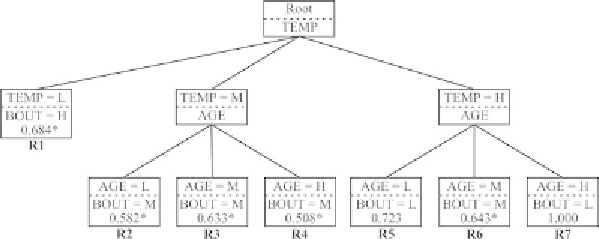Biomedical Engineering Reference
In-Depth Information
Figure 8. Membership functions of the linguistic terms, L, M and H, defining the linguistic variables of
the two continuous condition attributes, TEMP and AGE
Figure 9. Fuzzy decision tree for torpor bout problem
(modal) defining values of its neighbouring inter-
vals (so here α
2,1
= 13.93 and α
2,5
= 172.00). In the
case of the constructed intervals for the BOUT
attribute given in Table 8, Figure 7 elucidates the
sequence of linear piecewise (triangular) MFs
which describe the linguistic terms associated
with the BOUT decision attribute.
The MFs presented in Figure 7 clearly show
how the defining values have been employed, as
described earlier, for example the MF m
BOUT,M
(⋅)
has the associated defining values [13.93, 22.40,
60.84, 94.63, 172.00].
Five possible condition attributes, which may
be associated with torpor bout duration, were
investigated; 1 - TEMP, the average ambient
temperature over the duration of the torpor bout;
2 - WINTER, the period of winter in which the
torpor bout took place from early winter to late
winter/spring (see Park et al. 2000 for details); 3
- YEAR, the year in which the bat was monitored
(1995/6 and 1996/7); 4 - AGE (from 1 to 9 years);
and 5 - SEX (M or F). According to different hy-
potheses as to why bats arouse during winter, these
variables, with the exception of YEAR, might be
expected to influence torpor bout durations in
different ways (see Park
et al
., 2000).
Similar sets of MFs can be constructed, as
given before, for the two continuous attributes
that are included in those that describe the bats
and environment at the time of the torpor bouts,



Search WWH ::

Custom Search